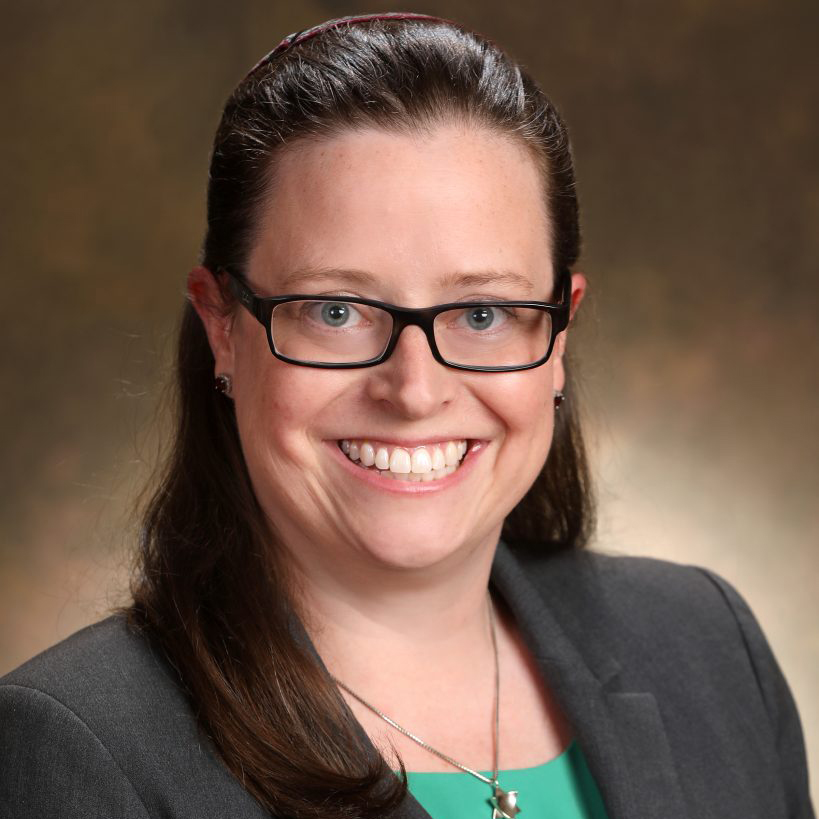In 2017, I flew to Chicago with five teenagers from my youth group in order to attend a national conference that brought together hundreds of Jewish teens. One of the teens, let’s call her Hannah, was adopted from China as an infant. Before our trip, I had not thought much about Hannah’s Chinese heritage. In fact, it was another teen in the group who had been studying hard for his Mandarin test on the plane ride there. I had not known Hannah’s family during the adoption process, and she fit in to our youth group like any other teen.
My perspective changed in Chicago. On the second evening of the conference, Hannah came running up. “Rabbi Nichols! I found other Asian kids. We’ve been hanging out. This is so cool!” And then she was off, lost in a crowd of adolescents. Her excitement at finding other Asian kids made me pause. Hannah was comfortable in our youth group at home, so why were these new friends so significant?
What I came to understand was the importance of creating environments where people can bring their whole selves. And our whole selves are complex, and rarely fit into one box. Hannah’s reaction was not a comment against how she felt in our youth group at home, but rather an expression of the joy she experienced when she could embrace multiple facets of her identity at once. For me, this moment was a powerful testament to the inclusivity and richness of our community. We had created a space where teens felt safe enough to claim, and celebrate, their diverse identities.
Witnessing Hannah’s personal identity journey highlighted for me the Jewish value of m’shaneh habriyot, appreciating differences. The term comes from an ancient blessing found in the Talmud[1]: Baruch Ata Adonai, Eloheinu Melech haolom, m’shaneh habriyot / Blessed are You, Adonai our God, Ruler of the Universe, who makes creatures different. The Talmud instructs people to use this blessing upon seeing unique-looking people or animals. Among the cited examples are people with spotted skin, people who are unusually tall or unusually short, people born with distinct features, and even unique animals like elephants and monkeys. While this list might be puzzling, the core message is clear. This blessing is an expression of gratitude to God for creating diversity. This is a blessing that praises God for making us different from one another. It is human nature for people to seek out like people – people with similar physical features, beliefs, behaviors, or experiences. We naturally lean towards what feels familiar and safe. And yet, this ancient blessing urges us to marvel at the diversity of humanity.
Believe me when I say that the existence of this blessing does not indicate that our ancestors were diversity and inclusion experts. They were most definitely not. But we aren’t either. We all can see that our world is in need of repair; that we are living in a frightening time, where there is an increase of hate speech directed toward people of different races, religions, ethnicities, genders, sexualities, physical and mental disabilities, political orientations… and on and on. Our society appears to be increasingly intolerant of difference on any dimension. So, while I do not wish to romanticize Talmudic times, I am inspired by its words.
During my junior year of college, I kept a list of words that inspired me. I wrote down things I heard, or read, in a section of a journal called, “Rabbi Ideas.” Leaving aside the fact that I was already jotting down sermon ideas as a college student, let me tell you about one of the entries that I recently rediscovered. I had the privilege, that year, of eating dinner with Elie Wiesel before he gave a talk on our campus entitled, “Building a Moral Society.” The details of our dinner conversation are hazy. I was too nervous just being in his presence to recall what was said. But there was one idea from his lecture that felt so significant the moment he said it, that when I went back to my dorm room that evening, I opened the journal and wrote it down. He told us that in the pursuit of building a moral society he had started teaching respect in place of tolerance because tolerance implies superiority of one group over another.
Echoing this sentiment, Duke University professor Omid Safi highlights that the word tolerance originated in the fields of toxicology and pharmacology: measures of how much of a foreign substance a body can endure.[2] Applied to society, this puts the majority in the role of host and the minority in the role of poison or parasite. Not the metaphor that promotes an inclusive, peaceful society. Tolerance does not establish co-existence, but instead suggests that one person is generously allowing another person or group to be in their space – tolerating their presence.
Tolerance is undeniably a positive attribute. A tolerant community is far better than an intolerant one. But tolerance is just one step in a series of steps toward making a harmonious society. I would like to think that we can aim higher than mere tolerance of others’ differences; that our vision of a just society goes beyond allowing for others’ existence. A similar mindset led the Southern Poverty Law Center in 2021 to rename its educational initiative, changing it from “Teaching Tolerance” to “Learning for Justice.” Readers and participants had complained that the original name simply set too low a bar.
Elie Wiesel moved the bar from tolerance to respect. As documented by a teaching assistant, Wiesel once explained to a skeptical student, “I don’t like the word tolerate. Who am I to tolerate you? I prefer the word respect. I must respect you even if I do not agree with you. In fact, my disagreement may be an expression of my respect for you. If I truly respect you, don’t I owe you my honesty?”[3] Wiesel’s qualification here that respect does not indicate agreement is an important one. Respect, in this case, acknowledges another person’s humanity and makes room for their uniqueness. Respect requires interaction, whereas tolerance breeds distance. Respect means listening to another’s point of view, and openly and honestly sharing our own.
The Talmud is renowned for including multiple points of view on a single topic. In the same passage where we learn the blessing of m’shaneh habriyot the rabbis ponder what to say when a person sees a multitude of diverse people, rather than one unique individual. They settle on the following: Blessed is God Who is wise in secrets, for just as their faces are not similar one to the other, so too the opinions of one are not similar to another’s.[4] What a refreshing sentiment! You see a jumbled crowd of people and instead of trying to search out your friends or find people who look like you, you pause and bless God for making each person, inside and out, unique.
This sentiment stands in stark contrast to the age-old pressure of assimilation. For most of our country’s history, expressions of racial, cultural, and ethnic diversity were suppressed in favor of fitting in. The classic image of the melting pot encouraged immigrants to assimilate and take on a homogenized “American” identity. And while the melting pot was presented as positive and welcoming, reassuring everyone that they would find their place in America, the image of the blended American it held up as a goal did not reflect the diverse reality of the population.
In 1977, the popular educational program, Schoolhouse Rock, aired “The Great American Melting Pot.”[5] The song and cartoon depict white immigrants sailing from Europe in the 19th century, diving off the handle of an animated cooking pot, shaped like the United States, in order to swim with dozens of other immigrants. While the lyrics include the lines, “You simply melt right in, doesn’t matter what your skin,” the narration and the cartoon characters depict an almost exclusively white-European story. The song even mentions how the narrator’s grandparents paid for their tickets and sailed past the Statue of Liberty. This certainly does not describe how the ancestors of many Americans arrived on our shores. The cheery voices encouraging us to “melt right in” are dismissive of race, religion, and culture.
Assimilation pressured individuals to conform, pushing their diverse traditions and ideas to the side. In contrast, the value of m’shaneh habriyot perceives differences not as barriers, but as blessings. It champions a society filled with different faces and stories. American Jewish philosopher Horace Kallen railed against assimilationism, professing that “democracy involves, not the elimination of differences, but the perfection and conservation of differences.” It aims, he said, “not at uniformity, but at variety.”[6] It’s tempting to wonder whether Kallen, whose father was a rabbi, ever drew inspiration from the blessing of m’shaneh habriyot.
Back in our Talmud passage, the introduction of the second blessing, upon seeing a diverse crowd, is followed by an appreciation for the strength a community brings to an individual. The Talmud laments, “think about all the work that Adam had to do in the Garden of Eden just to make a loaf of bread or create a single piece of clothing! And now, there are different people who do different parts and contribute to the whole.”[7] The Talmud is making the case for diversity – it is demonstrating the benefits of bringing together different kinds of people with a variety of ideas, experiences, and skills. The Talmud was ahead of its time: business and science journals today are full of studies showing that diverse teams foster creativity and innovation. A team made up of diverse individuals has the potential to examine a challenge from different perspectives and to draw on the unique experiences of each person, bringing together solutions that could never have been imagined by a single individual or by a homogeneous group.
Unfortunately, we cannot experience the true benefits of a diverse community simply by bringing together a variety of people. It’s not that simple. Fully embracing diversity requires pushing past assumptions, stereotypes, judgment, and hate. Fully embracing diversity pushes us out of our comfort zones and exposes us to fresh perspectives. Fully embracing diversity is an ongoing endeavor, and it’s hard work.
Harvard University’s Pluralism Project provides some helpful insights for this work. First, they teach that pluralism is an “energetic engagement with diversity.”[8] Diversity is a given, but pluralism requires diverse groups to have real encounters and relationships with one another. Pluralism requires us to cultivate diversity in our lives – to look for opportunities to meet and develop deep relationships with people whose appearances, beliefs, traditions, abilities, experiences, or families are different than our own.
A second insight echoes Elie Wiesel: “Pluralism is not just tolerance, but the active seeking of understanding across lines of difference.”[9] Tolerance does not require real knowledge of the “other,” risking dangerous stereotypes remaining in place. Active efforts to understand differences can lead to understanding, communication, and ultimately, cooperation. Jim Sinclair, founder of Autism Network International, suggests that when meeting new people, “Approach respectfully, without preconceptions, and with openness to learning new things, and you’ll find a world you could never have imagined.”[10]
A third guideline feels especially salient in today’s cultural landscape: “Pluralism is not relativism, but the encounter of commitments.” Assimilation encouraged groups to blend, abandoning unique customs, beliefs and needs. Pluralism celebrates individual identities – whether religious affiliation or cultural heritage or political leanings. Pluralism assumes that individuals will maintain their commitments but will bring them into relationship with the other, allowing them to be in dialogue and to enrich the broader society.
Navigating this guideline is complex. Too often, we enter conversations with people who believe differently than us with an assumption that we can change their minds, that if they just hear us out they will realize their mistakes. But when we do that, when we go into a situation thinking that the object is for one side to win, we are undermining the essence of m’shaneh habriyot. We are sidestepping genuine engagement with others. While each side is trying to beat the other, we are missing the opportunity to learn. Elie Wiesel wisely counseled, “The choice is to listen, or not. I hope that you listen, really listen, not to find the other’s weakness but to find his strength.”[11] If we can appreciate differences, if we search out the strengths of the people around us, we can create entirely new solutions, woven together from the collective wisdom of the group.
There is an old Yiddish folktale that tells of a man who would sit at the entrance of a walled city each day. Travelers would approach him and ask, “What kind of people live in this city?” Before answering, the man would ask his own question: “What kind of people live in the place where you came from?” To the travelers who answered, “Only bad people live in the place where we came from,” the man would reply, “Continue on. You will find only bad people here.” To the travelers who answered, “Good people live in the place where we came from,” the man would reply, “Enter. Here you will find good people as well.”
Diversity is a fact. Differences surround us. But to live out the value of m’shaneh habriyot, appreciating those differences, we need to enter situations as if we are the travelers who always find the good in people. We need to be open to getting to know the people around us, to learning their stories, to understanding their differences, and to finding their strengths. Only then can we move past intolerance, right through tolerance and on to pluralism. Baruch Ata Adonai, Eloheinu Melech Haolom, M’shaneh Habriyot / Blessed are You, Adonai our God, Ruler of the Universe, who makes creatures different. Blessed are You, Adonai our God, Ruler of the Universe, who inspires us to embrace difference and to weave together a healthy and holy diverse community.
[1] Talmud Yerushalmi Brachot 9:1
[2] Omid Safi, The Trouble with Tolerance. https://onbeing.org/blog/omid-safi-the-trouble-with-tolerance/
[3] As quoted in Witness: Lessons from Elie Wiesel’s Classroom by Ariel Burger, 2018.
[4] Talmud Yerushalmi Brachot 9:1
[5] Schoolhouse Rock. https://www.youtube.com/watch?v=5ZQl6XBo64M
[6] Quoted in https://pluralism.org/the-right-to-be-different
[7] Talmud Yerushalmi Brachot 9:1
[8] https://pluralism.org/about
[9] As quoted in Witness: Lessons from Elie Wiesel’s Classroom by Ariel Burger, 2018.
[10] Andrew Solomon, Far From the Tree, 2013.
[11] As quoted in Witness: Lessons from Elie Wiesel’s Classroom by Ariel Burger, 2018.




